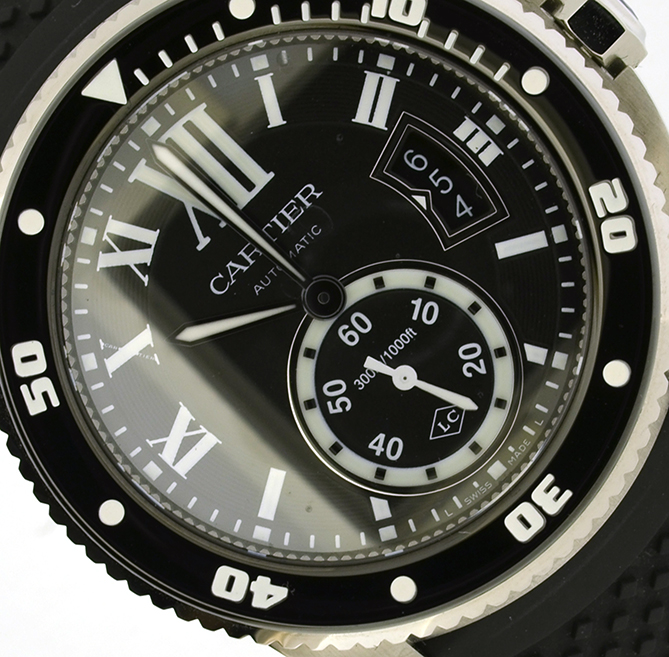

His blue Seamaster 300M became the emblematic Seamaster, most recognized for its blue bezel and blue wave dial. This collection was made truly famous when Pierce Brosnan wore a quartz Seamaster 300M in the 1995 Bond movie, GoldenEye. Current production models have switched to ceramic bezels (from aluminum) and ceramic dials with laser-engraved waves. Many models also feature a wave pattern on the dials. Some of the Seamaster Diver 300M’s key features are the scalloped bezel, helium escape valve at 10 o’clock, and skeletonized sword-shaped hands. It offers a water resistance rating of 300 meters, and features a helium escape valve on its case, allowing it to be used for saturation diving applications.
#PRE OWNED CARTIER CALIBRE DIVER PROFESSIONAL#
The Omega Seamaster Diver 300M is a professional diving watch. Today, the Seamaster product range encompasses a broad number of styles, suitable for every situation. Through the years, they have also introduced clever tweaks and line extensions that revive Seamaster models from the previous decades, such as the Seamaster 300, the PloProf, and the Seamaster 1948. Omega also demonstrated that its classics can be reinvented.

In the 2000s, Omega introduced two new sub-collections – the Omega Aqua Terra, a line of casual-to-sport watches with 150m water resistance and the Omega Planet Ocean, a line of professional diver’s watches with 600m water resistance. The Seamaster became the official watch of James Bond, and the ties to the Bond film franchise have continued ever since. The Seamaster Diver 300M was featured on the wrist of Pierce Brosnan, when he played 007 in the 1995 film GoldenEye. In the 1990s, a major marketing move contributed a surge in the Omega Seamaster’s popularity. These models are the forefather of the PloProf, a cutting-edge watch that was worn by professional divers and used by French diving company COMEX. In 1970, Omega introduced the “PloProf” or Plongeur Professional family, consisting of the Seamaster 600 and Seamaster 1000 - thereby doubling and tripling the water resistance of Omega watches. The Seamaster 300 went through several iterations in the 1970s, improving its technology further. It eventually gained a reputation as a true tool watch, and accompanied renowned explorer Jacques-Yves Cousteau on his Red Sea expeditions, proving that divers could thrive in gas saturate environments. It was the brand’s first dedicated dive watch, which in a bit of a misnomer, was rated to dive to depths of 200 meters. The following year, Omega introduced the Seamaster 300. Dubbed the 1957 Trilogy, each of the three watches catered to a specific purpose – the Seamaster for diving, the Speedmaster for racing, and the Railmaster for anti-magnetism. Omega capitalized on this movement and released their own set of “professional” watches in 1957. In the 1950s, the age of exploration gave birth to tool watches made for specific purposes and professions. With a water resistance of 60 meters, the original Omega Seamaster was marketed as a water-resistant practical every day watch, closer in design to today’s dress watches. So convinced was Omega with its abilities, that in 1956, the Seamaster was attached to an aircraft en route to the North Atlantic. This technology was used in submarines at the time and continues to be used today. What made the Seamaster revolutionary for its time was its use of a rubber gasket to secure the movement and provide water resistance. These feats made Omega well-respected for its diver’s watches and paved the way for the introduction of the Omega Seamaster in the following decade. Tested to withstand sub-aquatic depths, the Marine was worn by Yves Le Prieur, the inventor of the modern scuba mask and tank and explorer Charles William Beebe, who wore it while riding in a bathysphere. Omega’s diving heritage began in 1932 when they debuted the Marine, the world’s first commercially available dive watch. The very first Seamaster watch was introduced in 1948, and its design was loosely based on watches made for the British Royal Navy towards the end of World War II. The Omega Seamaster is the longest-running collection still being produced by Omega.


 0 kommentar(er)
0 kommentar(er)
